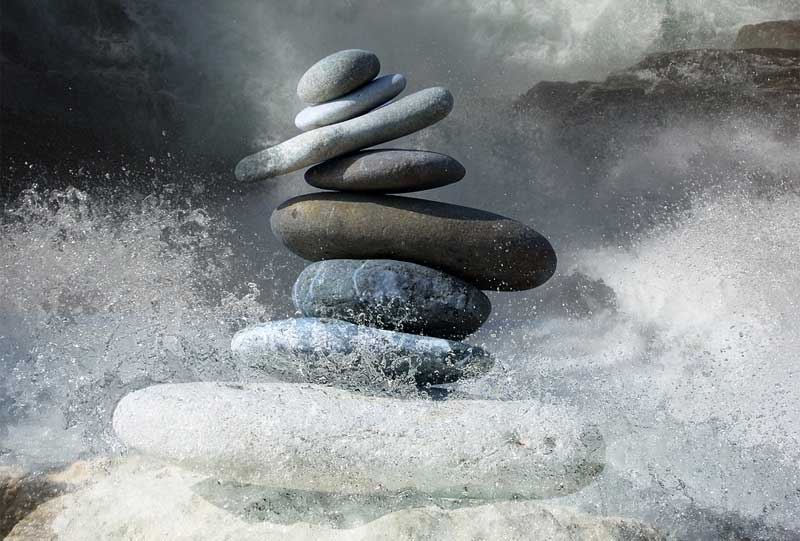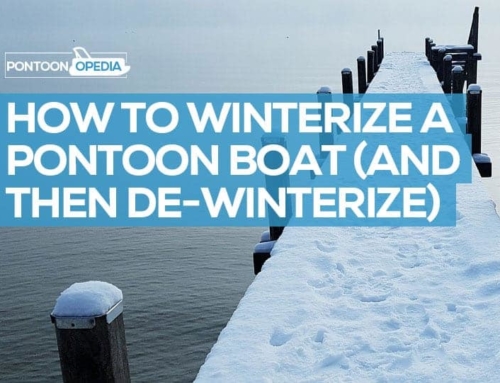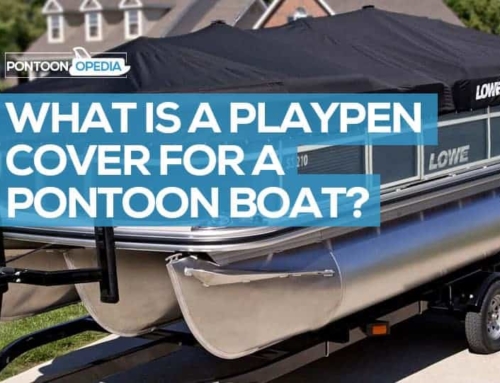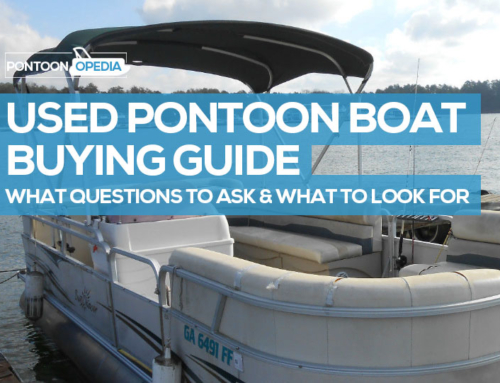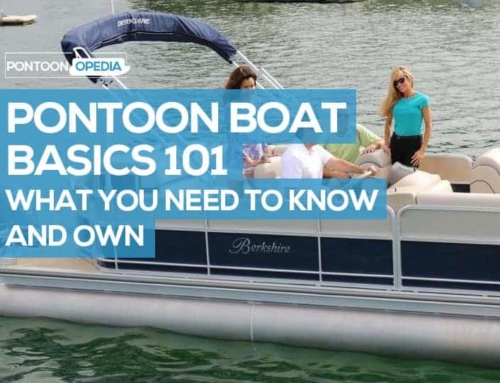If you are thinking about buying a pontoon boat, then one key question and concern you might have is how they handle in rough or choppy water. It’s an understandable concern, especially if you live in an area where weather can be unpredictable, or you aren’t an experienced boater.
Most of the time, your pontoon boat will be stable with no wobbles. But in very severe weather and storms, it can actually be more dangerous than a v-shaped hull boat.
The most important consideration is to use your common sense.
Common sense will serve you very well when captaining your pontoon in windy weather. But that’s only half the story, as you should really know what to do when you are in choppy water as a responsible owner.
Being prepared at all times is the best advice I can give you.
In this guide I am going to give you some tips based on my own experiences and that of other pontoon owners I know further down the page.
This guide will explain how well they can handle, some additional tips on what you can do avoid rough weather conditions, as well as what you should do in the event of being in choppy water.
How Well Do Pontoon Boats Handle in Rough Water?
How well do pontoon boats handle in rough water, wind, and weather?
As a general rule of thumb, pontoon boats fare pretty well in windy conditions and choppy water and are almost un-sinkable. This is due to the way in which they are designed, with at least two hulls.
The two-hull approach offers a lot more stability than one hull will in rough conditions – even more so if you have a tritoon with three hulls (see how they compare).
As I have said, in really severe weather, they can be dangerous, but overall, pontoon boats are only as safe as the people in charge of them.
Will a Pontoon Boat Flip-Over in Rough Water?
They can flip, and it has happened from time to time (see this news report on YouTube), but if you are a responsible owner, keep an eye on weather forecasts, don’t take risks, and avoid certain situations then it’s unlikely that your pontoon will flip or capsize.
If you do get hit by large waves at the front of your pontoon boat, the pontoons can go under the wave instead of riding it. On very rare occasions, this could lead to capsizing, flipping, and tipping.
How to Handle a Pontoon Boat in Rough or Choppy Water
Whilst you can never control how windy it’s going to be, what you can do is take the necessary steps to ensure that you reduce the chances of being flipped over in rough weather.
- Keep an eye on the skies and look out for wind approaching
- If there is a storm coming, get off the water
- If you don’t have time to get back to shore, considering anchoring the pontoon
- Don’t try to force the turn too much in the wind
- Keep an eye on your load and pontoon weight load calculations
- Make sure your passengers know the importance of a maintained balance
- Adjust your course to ride into the waves properly taking a wave at an angle
- Trim up just before hitting a wave
- Keep the pontoons above the water
- Don’t let the nosecones bury
Let’s go into a few of those pointers in more detail.
Firstly, you should always maintain an even load on your pontoon boat. Not just the equipment and cargo, but also your passengers as this can affect how well the boats handles in choppy water.
Before you set off, think about the weight distribution, how much your pontoon weighs, and make your passengers aware of how important it is that they balance the boat out evenly.
The weight distribution of your boat can also be affected by any modifications you might have made. For example, if you have added a custom upper deck, or made yours into a double decker, the balance and center of gravity will be affected. It will be more prone to tipping over in rough water.
The larger the pontoon boat, the more elements you will need to consider for stability.
With regards to handling, the turning radius of a pontoon boat is never going to be that good. Pontoon boats are not designed for hair-pin turns and performance turns. In rough water, take your turns easy and wide.
Don’t Slow Down
A common misconception is that you should slow down before hitting a trough. This isn’t the case, and if you do so, you could put yourself at risk of dipping the nose under the water. That water is potentially going to come on-board the pontoon once it crashes over the bow.
I made the mistake of slowing down once and have never done it again.
When approaching big waves, the trick is to ensure that the pontoons stay above the water, as you don’t want to bury the nosecones. By slowing down as you make your approach, the bow can drop, meaning waves will come into the boat. You don’t want that to happen.
If you are cruising into big waves, instead what I advise you to do is adjust your course so that you ride properly into them. How do you ride properly into a large wave though?
It’s simple. Rather than riding head-on into them, instead cruise so that the waves are at a 30 to 45-degree angle from the boat’s center.
By taking the waves at an angle, you can help to keep your bow high as well as one of the tubes. This lets the pontoon boat glide far more smoothly through the troughs and peaks.
Bear in mind though, that you still might run the risk of dipping the corner of the pontoon. Trim up just before you hit a wave as the bow of the pontoon will lift.
If you do get water inside of your pontoon boat, you are going to get damage to the playpen. This won’t be cheap to fix.
So really, you want to avoid boating in rough water altogether if you can and the best way you can do that it with good planning and foresight.
Watch the Weather & Water Before You Take Your Boat Out
I always check the marine forecasts before I set out – you should do the same every time you take your boat out.
If you do get stuck out on the water with some unexpected conditions, then try to turn back. It’s better to be safe than sorry, and I would always rather head back to shore over trying to get another few minutes out on the lake.
But even if you do get to dock in-time, you still might run into some problems if the storm is starting to get really heavy.
Docking Your Pontoon Boat in Bad Weather
Once you’re off the water, you might have another problem to deal with; docking.
The high profile of a pontoon boat can make it really difficult to tie down or get back on your trailer during high winds and storms.
High winds can pound the boat, and push it against the dockside, possibly damaging it and leading to expensive repairs.
To conclude, don’t boat in stormy weather, and if you see high winds and rough water approaching, get back to shore and get it loaded back on the trailer before it’s too late.
Modifications to Keep a Pontoon Boat Stable in Choppy Water
An additional idea you might want to consider for helping keep your pontoon boat stable in choppy waters, would be some modifications.
Those could include aspects such as:
- Increase the horsepower
- Invest in power-assisted steering
- Add positive angle lifting strakes
- Add barracuda nosecones
- Add under skinning to reduce drag
These items could help your pontoon boat handle rough waters a little better.
Comments from Other Pontoon Owners
Everything I have talked about in this article about how pontoon boats are in rough water, are my own views.
I also canvassed opinion on some of the leading pontoon boat forums and have compiled those into comments below, so you can read for yourself what other people have to say.
“If the waves are not too big, then it’s not that bad. You might get wet, but that’s half the fun of pontoon boating! In very windy conditions, it can be hard to properly anchor, but you can improve that by changing the side to chain link. The best thing I advise is to get someone who already owns a pontoon boat to take you out on a slightly windy day and see for yourself how comfortable you would be.”
“I own a 25-foot tri-toon and can easily get on top of 3-foot waves. I’ve never had any handling problems in choppy waters and tend to drift in up to 25 miles per hour winds with the help of drift socks. I love my pontoon and would recommend anyone buy one. I wouldn’t swap it for the world.”
“If I can offer one piece of advice as a pontoon boat owner of 20 years, it would be to under-skin it. This has helped immeasurably with cutting down on water spray and dragging. If you have a heavy load then you might get more spray at the front as the strakes are never wide enough to disperse all the water, but generally speaking I have no problems in rough water but would never go out in a storm obviously.”
“I do get spray in choppier waters, but really don’t care especially if it’s a hot day. What I did was a modification and used aluminium sheeting to provide under-skinning under the deck. This has reduced the amount of water spray, and also given me a slighter faster and smoother ride.”
“My pontoon boat does tend to catch the wind, and I do find it hard to anchor down on really blustery days. When I drift when fishing, I can get blown about quite a bit if there’s a high wind. If I know that it’s going to be a rougher day than usual, then I make sure I have a partner with me to help dock.”
“On a normal day, I really don’t think you will get a better experience than riding a toon. Yes, there will be water spray once you hit speeds of 30 miles per hour, but then you get that when there are other boats out on the lake too. My pontoon is ultra-stable on the water, and I love to ride the waves.”
Conclusion
Pontoon boats are not designed to be used in storms and very rough water.
Whilst they can handle average waves, if it gets really choppy you could experience some problems, but it’s how you handle the waves to prevent any danger.
Always check the marine forecast before you set off, be sensible, and make sure that your passengers are aware of their own responsibilities, and you should have huge amounts of fun on the water.
Pontoon boating deaths are extremely rare, as generally, they are a very safe boat.
Common sense, planning, and preparation are your key tools to riding out the potential for rough water and winds.
Keep safe, and happy pontooning!

